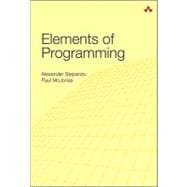
What is included with this book?
Alexander Stepanov studied mathematics at Moscow State University from 1967 to 1972. He has been programming since 1972: first in the Soviet Union and, after emigrating in 1977, in the United States. He has programmed operating systems, programming tools, compilers, and libraries. His work on foundations of programming has been supported by GE, Brooklyn Polytechnic, AT&T,HP, SGI, and, since 2002, Adobe. In 1995 he received the Dr. Dobb’s Journal Excellence in Programming Award for the design of the C++ Standard Template Library.
Paul McJones studied engineering mathematics at the University of California, Berkeley, from 1967 to 1971. He has been programming since 1967 in the areas of operating systems, programming environments, transaction processing systems, and enterprise and consumer applications. He has been employed by the University of California, IBM, Xerox, Tandem, DEC, and, since 2003, Adobe. In 1982 he and his coauthors received the ACM Programming Systems and Languages Paper Award for their paper “The Recovery Manager of the System R Database Manager.”
| Preface | p. ix |
| About the Authors | p. xiii |
| Foundations | p. 1 |
| Categories of Ideas: Entity, Species, Genus | p. 1 |
| Values | p. 2 |
| Objects | p. 4 |
| Procedures | p. 6 |
| Regular Types | p. 6 |
| Regular Procedures | p. 8 |
| Concepts | p. 10 |
| Conclusions | p. 14 |
| Transformations and Their Orbits | p. 15 |
| Transformations | p. 15 |
| Orbits | p. 18 |
| Collision Point | p. 21 |
| Measuring Orbit Sizes | p. 27 |
| Actions | p. 28 |
| Conclusions | p. 29 |
| Associative Operations | p. 31 |
| Associativity | p. 31 |
| Computing Powers | p. 33 |
| Program Transformations | p. 35 |
| Special-Case Procedures | p. 39 |
| Parameterizing Algorithms | p. 42 |
| Linear Recurrences | p. 43 |
| Accumulation Procedures | p. 46 |
| Conclusions | p. 47 |
| Linear Orderings | p. 49 |
| Classification of Relations | p. 49 |
| Total and Weak Orderings | p. 51 |
| Order Selection | p. 52 |
| Natural Total Ordering | p. 61 |
| Clusters of Derived Procedures | p. 62 |
| Extending Order-Selection Procedures | p. 63 |
| Conclusions | p. 63 |
| Ordered Algebraic Structures | p. 65 |
| Basic Algebraic Structures | p. 65 |
| Ordered Algebraic Structures | p. 70 |
| Remainder | p. 71 |
| Greatest Common Divisor | p. 76 |
| Generalizing gcd | p. 79 |
| Stein gcd | p. 81 |
| Quotient | p. 81 |
| Quotient and Remainder for Negative Quantities | p. 83 |
| Concepts and Their Models | p. 85 |
| Computer Integer Types | p. 87 |
| Conclusions | p. 88 |
| Iterators | p. 89 |
| Readability | p. 89 |
| Iterators | p. 90 |
| Ranges | p. 92 |
| Readable Ranges | p. 95 |
| Increasing Ranges | p. 103 |
| Forward Iterators | p. 106 |
| Indexed Iterators | p. 110 |
| Bidirectional Iterators | p. 111 |
| Random-Access Iterators | p. 113 |
| Conclusions | p. 114 |
| Coordinate Structures | p. 115 |
| Bifurcate Coordinates | p. 115 |
| Bidirectional Bifurcate Coordinates | p. 119 |
| Coordinate Structures | p. 124 |
| Isomorphism, Equivalence, and Ordering | p. 124 |
| Conclusions | p. 131 |
| Coordinates with Mutable Successors | p. 133 |
| Linked Iterators | p. 133 |
| Link Rearrangements | p. 134 |
| Applications of Link Rearrangements | p. 140 |
| Linked Bifurcate Coordinates | p. 143 |
| Conclusions | p. 148 |
| Copying | p. 149 |
| Writability | p. 149 |
| Position-Based Copying | p. 151 |
| Predicate-Based Copying | p. 157 |
| Swapping Ranges | p. 164 |
| Conclusions | p. 168 |
| Rearrangements | p. 169 |
| Permutations | p. 169 |
| Rearrangements | p. 172 |
| Reverse Algorithms | p. 174 |
| Rotate Algorithms | p. 178 |
| Algorithm Selection | p. 186 |
| Conclusions | p. 189 |
| Partition and Merging | p. 191 |
| Partition | p. 191 |
| Balanced Reduction | p. 198 |
| Merging | p. 202 |
| Conclusions | p. 208 |
| Composite Objects | p. 209 |
| Simple Composite Objects | p. 209 |
| Dynamic Sequences | p. 216 |
| Underlying Type | p. 222 |
| Conclusions | p. 225 |
| Afterword | p. 227 |
| Mathematical Notation | p. 231 |
| Programming Language | p. 233 |
| Language Definition | p. 233 |
| Macros and Trait Structures | p. 240 |
| Bibliography | p. 243 |
| Index | p. 247 |
| Table of Contents provided by Ingram. All Rights Reserved. |
The New copy of this book will include any supplemental materials advertised. Please check the title of the book to determine if it should include any access cards, study guides, lab manuals, CDs, etc.
The Used, Rental and eBook copies of this book are not guaranteed to include any supplemental materials. Typically, only the book itself is included. This is true even if the title states it includes any access cards, study guides, lab manuals, CDs, etc.